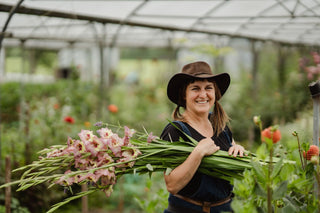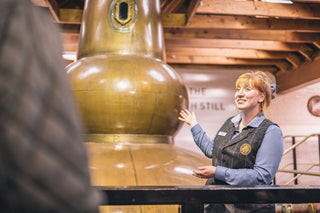Situated along the scenic A85 route leaving Crieff towards Comrie, Tomnah’a Market Garden comfortably resides in the lush landscape of rural Perthshire, on a 5 acre plot forming part of Comrie Croft’s 230 acre estate.
Initially set up in 2015, the garden was born from a desire to build local food security, provide a vital community resource and a safe space for nature to thrive. Tomnah’a is an inspiring enterprise that puts sustainable practices such as agroecological farming and increasing biodiversity at its heart.
Now several years on, Tomnah’a continues to develop and grow the produce and experiences that it offers. As a key supplier to The Glenturret Lalique Restaurant, we aim to raise awareness around the important work that the team and volunteers at the garden undertake and we celebrate the synergies in traditional methods and by-hand processes that both our businesses share.
The farm currently operates with 3.5 full time employees, 4 seasonal part-time and trainee employees, and several regular volunteers who add a lot of value. The farm’s agroecological market gardening of a large diversity of crops on a small but intensive scale for local consumption, relies on and creates more jobs per acre than conventional farming could. It is recognised that 71% of the UK is agricultural land but only 1% of the workforce are employed in agriculture. Whilst there is a need for different types of farming, there are clear benefits to market gardening that add so much to rural communities in terms of employment opportunities, whilst also supporting a more sustainable and local food economy. Tomnah’a has trained and mentored 14 new entrant young people as market gardeners who have subsequently all gone on to work in agriculture and horticulture in some way, either setting up their own ventures or working for other farms. Supporting new entrant farmers into the workforce is incredibly important to the team, especially given how few opportunities exist for training in the sector for people not from a farming background.

In 2023, Tomnah’a were able to offer 150 ‘veg shares’, with a range of small, medium, and large veg box options available. The scheme runs for 26 weeks beginning in May each year. The farm ask their veg share members to pay on a 'sliding scale' according to their level of disposable income in order to provide boxes at a reduced cost to low-income families while continuing to pay all staff a living wage. Presently, 21 families are signed up to the low-income payment tier. Additionally, the farm have donated organic staples such as potatoes, carrots, and apples to the Crieff Foodbank for a number of years, using surplus funding from the veg share tiered payment scheme.
Preserving the health of the soil is key to the farm’s success. Akin to producing top quality barley for whisky, making the terroir is critical to creating optimum growing conditions for the farm’s produce. With each crop removing and adding something different to the soil it is important to rotate the crops and preserve vital nutrients. The farm doesn’t use any pesticides or herbicides and the team work the soil by hand and using low-impact tools such as a wheel hoe to ensure that it is disturbed as little as possible. Soil is a living organism and the more that you disturb it, the higher the potential for damage and biodiversity loss. Biodiversity in the soil is the most important part for a biodiverse farm and the future of food security. And that improves the produce that grows (including weeds!) and helps to increase the biodiversity above ground. Quite often, the team will leave some of their crops to go to seed which in turn also helps biodiversity through habitat and food provision.
The team will typically wait 6-8 years before they plant the same crop into the same bit of land. There are some plants such as legumes which are known as nitrogen fixing plants, which the farm use to boost levels in the soil if planting future crops that are known to require high levels of nitrogen to grow. Similar to whisky making principles and observing what casks we’ve laid down many years before to what we will mature in the future, the farm continually refers to previous years in order to help plan future growth.
Throughout the year the farm is constantly evolving particularly in the Summer months with colours and produce bursting into life. The top beds of the farm can be seen early on from the entrance and hold an array of quick growing crops and salads. This area is frequently used by our kitchen team for experimental crops that will be used in our restaurant dishes.
Opposite the top beds on the other side of the farm lies an edible forest section that the team are ever expanding to include both native and less-common species. The farm is also home to an array of berry bushes of which the small variety are often used for the delicate dishes in the restaurant.
As you walk towards the front of the farm nettles can be seen in abundance. Another indicator of nutrient rich soil and an excellent source of vitamin C, at certain times the team can use these in recipes such as pesto for team lunches. The farm’s polytunnels are home to a further diverse range of food crops and flowers. With the tunnels reaching around 40 degrees in the summer the team work earlier in the day to combat the heat. The tunnels have a 4 year rotation due to their current capacity and everything inside them is meticulously pruned to manage growth and maximise fruit and veg production which is evident everywhere that you look from one abundant plant to the next.
The farm make their own compost in addition to purchasing organic mushroom compost which has an excellent texture and life for growing in. Across several parts of the farm there are many sections of plastic sheeting which act almost as jackets helping to protect the soil and to keep weeds down with no pesticides being used. Every year the farm reuses these coverings, and the plastic is not thrown away. This is the most sustainable way to avoid using chemicals on the soil, though Tomnah'a are interested in non-plastic alternatives as new technologies are developed. The plastic is also very useful as it can be moved around the farm and doesn’t alter any of the elements such as the pH of the soil. One of the many benefits in protecting the soil is preventing excess carbon from being released into the atmosphere, the healthier your soil is the more carbon it stores.
Although the farm does not use herbicides or pesticides, they do occasionally use alternative amendments to the soil. For example, for their tomatoes, they use Epsom salts or organic chicken manure and mushroom compost to help boost plant growth. Plants such as comfrey can also provide nutrient provision. Around 90% of conventional farming costs are related to inputs and infrastructure whereas Tomnah’a is mainly driven by wage prices, making its operation very economically and ecologically stable whilst providing more jobs per kilo of food produced.
Hedgerows dotted about the farm provide food, shelter and habitats for nesting birds and they can be seen and heard in abundance in addition to other thriving species such as bats, moths, butterflies, and frogs. As well as biodiverse soil principles the farm is incredibly resourceful and energy conscious. Over 90% of the farm’s irrigation is drawn from rainwater harvesting whilst the farm’s power comes from a Solar array located at Comrie Croft.

In addition to the high quality fruit and veg grown on the farm, Tomnah’a is also home to a beautiful flower garden. The incredible floristry team celebrate natural growing, slow flowers and floral farming. They grow for weddings, wholesale floristry and a small amount of retail. Throughout The Glenturret Lalique Restaurant, masterful creations made from Tomnaha’s dried flowers are on display. The quality of flowers showcased, sets the tone for our celebration of local produce and emphasis on traditional practices.
Great care is taken by the team to grow and prepare flowers for the drying process before they make it to the Lalique vases in the restaurant. The process begins with the team selecting an assortment of flowers such as Ginger Mint and Helichrysum with the restaurant in mind. Everlasting flowers are particularly good for drying as they hold their foliage and have a similar colour and appearance when dried. The farm pick the selected flowers as if they were to be used for fresh flower displays early in the morning. The drying process involves stripping all of the excess foliage to stop mould forming on the flower for aid drying. The flowers are bundled as per arrangement requirements and then the team condition the flowers by putting them in water for 12 – 24 hours to make sure that they’re hydrated and in optimum condition. Once conditioned the flowers are then hung upside down from their stems in the insulated, dark, drying room to hold their shape while they dry. Drying typically takes around a few weeks depending on the flower type.
The Angelica flowers in our restaurant are a great example of the floristry team waiting until the perfect moment to pick the flowers and preserve their state through the drying process for maximum impact, capturing the beauty of the plant. Picked at the precise ripeness the floristry team’s arrangements compliment both the space and unique gastronomic experience of the restaurant seamlessly.
With limited space and resource, the farm somewhat relies on their wonderful volunteers to support their operation. The team are constantly juggling dry and wet spaces for both fresh and dried flowers and sadly lose around a third of their dried flowers each year due to the many challenges around the drying process and lack of suitable drying space. The demand for dried flowers has increased over the past few years particularly with sustainability in mind and the seasonality of flowers. Any flowers that are not used for displays will of course still help with pollination and biodiversity on the farm and ultimately will become compost. The drying season begins around June and runs through until January. Importantly, the drying process is all natural with no dyes, bleaching or chemicals often used in commercial floristry where flowers are typically grown on mass and are stripped, bleached, dyed, and often shipped across the world resulting in a significant carbon footprint. In contrast the farm is local and has a minimal footprint and all of the flowers are natural in colour and are sustainably grown. Similarly, to building knowledge in the community around food production the farm is also keen to encourage others to learn more about flowers through its pick your own flower sessions.
Tomnah’a is an inspiring business that is sadly too small to receive farming subsidies through the current Defra system, despite the volume and diversity of food that they produce per acre compared to other conventional farms. Supporting market gardens such as Tomnah’a is incredibly important and why we are delighted to work with them and support their business and the many community benefits that they offer.
Discover more about Tomnah’a Market Garden here.


